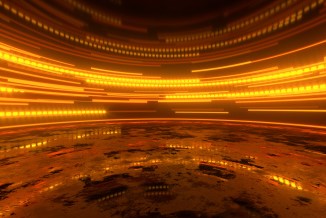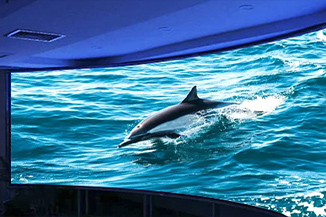Publisher: Supplier of LED Display Time: 2022-02-17 17:26 Views: 2009
Traditional large-screen display methods include: DLP splicing wall, LCD (liquid crystal) splicing wall, projection (projection fusion), and super-large LCD display.
1. Features of different display modes:

Second, the advantages and disadvantages of different display technologies:
1. Patchwork problem. Both LCD and PDP have stitching problems, DLP is slightly better, and projection fusion can deal with the stitching area when properly handled; the small-pitch LED display technology has no stitching at all.
2. Display effect. From the perspective of grayscale, contrast, brightness, refresh rate and other indicators, DLP rear projection and projection and fusion technology have the worst display effect (the worst is determined by the physical properties of the projection), and the LCD display effect is better, but after long-term use, Dark edges and black corners appear due to brightness attenuation. In addition, there will be differences in brightness and color between the screen and the screen, and the human eye is very sensitive to the difference;
LED display technology indicators such as grayscale, contrast, refresh rate are very good, and the problem of light decay can be easily solved by point-by-point correction, but the biggest problem lies in 2 points: ① Dead light: the standard of the dead light rate of outdoor LED displays is general It is 1/10,000 to 3/10,000, but the small-pitch LED standard needs to be greatly improved. Take the small-pitch LED display of the P2.5 specification as an example, there are 160,000 lamp beads per square meter; if the spacing is further At the level of 1 mm, there are 1 million lamp beads per square meter. At this time, according to the standard requirement of "no more than 3 dead pixels" of the LCD screen, it is almost impossible for the LED display to reduce the dead light rate to one million. three out of three. ②Contradiction between brightness and grayscale: One of the most significant differences between indoor and outdoor applications is the change in ambient light. When the LED display is used outdoors, the intensity of sunlight during the day is very high, so the outdoor LED display needs to be bright, bright and bright! The brighter the display, the higher the technical specifications of the display. For indoors, since it is often necessary to watch the display for a long time, the brightness of the LED display should be greatly reduced. The brightness range of the reference home TV is 350 cd/㎡-500 cd/㎡; the brightness range of the DLP video wall is 250 cd/ ㎡-400 cd/㎡; the brightness range of LCD video wall is 450 cd/㎡-700 cd/㎡. As a self-luminous display technology, LED is different from passive lighting, and the human eye is more sensitive, so it needs a lower brightness to be comfortable for the human eye. The LED display needs to be lower than about 300cd/square meter to achieve the best viewing effect of the human eye (the internationally recognized standard is that viewing with a brightness of more than 700cd/square meter will cause damage to human eye health. In addition, some special application fields The requirements for "low brightness and high gray" are more stringent. For example, TV studios sometimes even require the brightness of the display to be within 100cd/square meter). Looking at the specifications of small-pitch LED displays on the market, it is not difficult to find existing displays. There is a big gap between the brightness and the actual application brightness. Take a listed company in Beijing that produces small-pitch LED products as an example. The company's official website clearly indicates the specifications of LED small-pitch products. The brightness value is greater than 1200cd/㎡, which is much higher than the comfort zone. Professional test experts in the industry have conducted a large number of practical tests on small-pitch LED displays from multiple manufacturers and found that when the brightness of the display screen is reduced to 500 cd/㎡ or even from 600 cd/㎡, the picture has already begun to appear. More obvious gray loss phenomenon. And with the further reduction of brightness, the grayscale loss is also more and more serious. When the brightness is reduced to below 200 cd/㎡, the grayscale loss of most of the display screens is extremely large, and the picture quality is almost "unsightly". Therefore, how to achieve the minimum loss of grayscale at a brightness level of 300cd/square meter is a threshold for LED display application companies, which is also the moat of excellent companies.
3. Resolution. Both DLP and LCD have high resolution, and a single 60-inch display unit can achieve 2K high-definition resolution, while the small-pitch LED display technology is composed of lamp beads, so under the premise of controllable cost, resolution rate is lower than other technologies. For example, the resolution matching of the display screen and the signal source, the outdoor LED display screen used in advertising and other fields does not need to have a standard resolution, and the customer only cares about the display effect and brightness. After the small-pitch LED display enters the indoor application, the downstream application fields expand rapidly. In the fields of command, control, monitoring, etc., the display screen is often required to match the standard resolution signal output by each subsystem, such as the 1,920×1,080 signal of the high-definition camera. Wait. Within the specified size, the standard LED display cabinet may not be able to splicing out the required standard resolution.
4. Cost issues. Among all indoor large-screen display solutions, the lowest cost is LCD splicing and projection and fusion (because the lowest cost LCD video wall has the largest share in the indoor display field), followed by PDP splicing. At present, compared with the DLP rear projection splicing, the small-pitch LED display is difficult to say which is higher. Due to the small-pitch LED display with different dot pitch specifications, the cost varies greatly. At present, the price per square meter of the P1.9 display is the same as that of the DLP. Rear projection splicing is equivalent, but considering the difference in gross profit margin, the cost is even higher than DLP splicing products. For industry users who prioritize benefits, small-pitch LEDs may not be the first choice when considering comprehensive cost-effectiveness on the premise of meeting application needs. High cost has always been the main problem that plagued small-pitch LEDs, although small-pitch LEDs have many advantages. However, with the continuous investment in the market and the rapid improvement of small-pitch LED technology, the technical cost has been greatly reduced. At present, the commercial cost of products below P1.2 is too high, and users are still unable to bear it. This also means that before the current LED process technology has undergone major innovations, no matter how small the spacing is, it cannot be popularized at all.
5. Service life. In terms of the length of use, pure LED display technology has the longest service life, because in indoor applications, the LED display brightness requirements are very low, and 20% of the maximum output power can meet the requirements.
Third, the competition between different display methods.
1. Small-pitch LED VS DLP splicing: Small-pitch LED screens have advantages in seaming, brightness, color saturation, resolution, and application flexibility; while DLP splicing walls are more refined in terms of picture detail and cost. have an advantage. These two technologies will form a head-to-head competition in the high-end indoor market;
2. Small-pitch LED VS LCD splicing: Small-pitch LED screens have significant advantages in seamlessness, longevity, and flexibility; however, LCD splicing also has advantages in price and picture detail. However, affected by factors such as price, at this stage, small-pitch LED screens will mainly target the high-end market, while LCD splicing will mainly target the mid-to-low-end market, so the competition between the two is not very prominent;
3. Small-pitch LED VS projection fusion: Small-pitch LED screens have advantages in terms of color saturation, lifespan, post-maintenance, and demand for auxiliary equipment, and do not have high requirements for the use environment; while the projection fusion system has higher brightness, And a certain price advantage, especially in the creative projection display has an irreplaceable position. Therefore, the two parties will not replace each other, and the small-pitch LED screen may pose a challenge to the fusion display of engineering projectors in a specific application range;
4. Small-pitch LED VS large-size LCD: In comparison with the super-large LCD single screen, the so-called super-size LCD products cover the size range of 70-110 inches, while the small-pitch LED screen can cover from 70 inches to 70-110 inches. In theory, the range of infinite size, small-pitch LED product size range is wider, and the ability to meet market demand is also stronger. However, within the display size that can be achieved by liquid crystal, the fineness of the liquid crystal screen has obvious advantages, and most products are cheaper. The competition between the two has significant differences and certain contradictions. It is not a relationship of mutual substitution, but a complementary and cooperative relationship facing different needs.
As far as the current situation is concerned, for small-pitch LED display products, in indoor applications, if you want to compete with the more mature LCD splicing and DLP splicing, the urgent need to break through is not the technical bottleneck, but the temporary cost of the product. How to maximize the user's investment value when it cannot be reduced? After all, only "value for money" or even "value for money" can best meet the consumer psychology of consumers. At present, due to the cost problem, the promotion and application of small-pitch LEDs are still mainly concentrated in the high-end application market. However, with the increase of investment, the cost problem will not be a long-term problem that plagues the industry, and for some needs, the application effect takes precedence over the application. cost.









